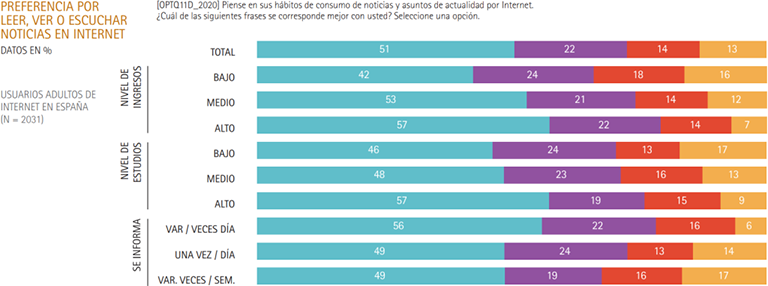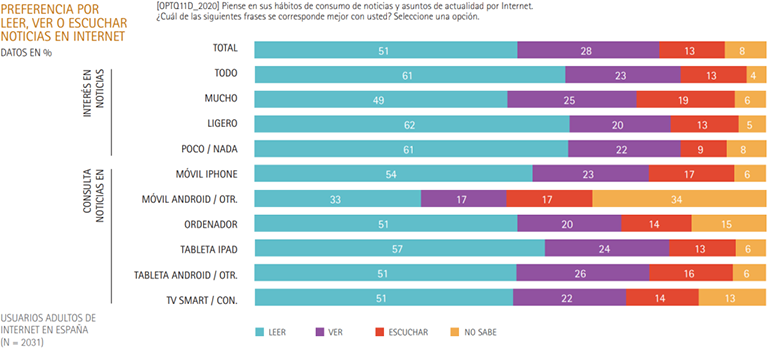-
Watching news online drops to 22%, and stands out among those who practice news use of a smart or connected TV (28%) and in the 18-24 age group (25%).
-
Listening to the news via the Internet is the main option for 14% of respondents and has grown six points in three years; it is practiced, above reading or watching the news, by one in five adults under 35 years of age (19%).
The continuous increase in the supply of audio and video journalistic content has led the survey Digital News Report to ask audiences once again which format they prefer for online news. In 2020, just before the Covid-19 pandemic, this question showed a balance between text and audiovisual formats, with a total predominance of video over audio. Three years later, and with a methodological change that includes in the survey those who did not receive information in the last month, the proportion of those who mostly read the news grows by four percentage points, up to 51%; the option of watching is reduced to almost half, with 22%, and the options of listening to the news grow, with 14% (almost double that of three years ago, when it was 8%), as well as indifference or indecision between the three formats, which goes from 5% in 2020 to 13% in 2023.

Among the three formats, there are only statistically significant differences between men and women in the preference for listening to the news, which is higher among men (17%) than among women (12%). Listening also shows notable differences by age, with adults under 35 years of age (19%) showing a maximum, and the 45-54 and over-65 age groups above average, with 15%, while adults between 55 and 64 years of age (10%) show the minimum. There are no significant differences by age in terms of reading and watching news on the Internet.

The preference for reading news on the Internet over watching and listening is related to the level of programs of study and income; although it is the preferred modality at all levels, the predominance is accentuated in the middle and high levels, mainly at the expense of "don't know". Although watching or listening to the news is more popular among users with programs of study or lower income levels, the differences with other strata are of lesser magnitude.
As for how this choice is influenced by how often users are informed, 56% of those who consult the news several times a day choose to read, five points more than all adult Internet users, while they remain practically at average watch (22%) and listen (16%, two percentage points more than the total); what is reduced by half (6%) is the group of those who do not know how to express a preference between one format or another. Somewhat differently, those who get information once a day read somewhat less (49%) and watch the news on the Internet somewhat more (24%), while they are close to average in terms of listening to the news (13%) and in the group who do not know (13%). Finally, those who are informed even less frequently (several times a week) show greater indecision (17%), less preference for watching the news when connected to the Internet (19%), and a similar proportion to other types of users in the rest of the modalities.

Those less interested in news also show more indifference with respect to the written, audiovisual or audio language in which they consume it; among them, the sum of the options of listening (17%) and watching (17%) is equal to, and slightly exceeds, the consumption of news by reading (33%). Those with a mild interest are very close to average in all four options. Meanwhile, those who are very or totally interested in the news halve their indecision (6%), and one in four opt to watch the information (audiovisual, of course), rather than read or listen to it.
Taking into account the devices through which news is accessed, Android users, whether cell phones or tablets, prefer reading by 61%, and those who get information through the computer, 62%, while those who use smart or connected TV for news purposes increase the preference for watching the news (via the Internet) to 28%, six percentage points more than the total. Apple iPhone (17%) and iPad (19%) users are more inclined to listen to the news than to read or watch it, although these other options also continue to predominate among users of Apple phones and tablets.
In international comparison, these data are close to the average of the 46 markets studied by the Digital News Report based on the survey, although the news viewing option is slightly below the total.